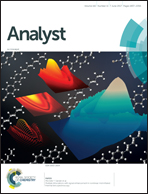Detection of early osteogenic commitment in primary cells using Raman spectroscopy†
Abstract
Major challenges in the development of novel implant surfaces for artificial joints include osteoblast heterogeneity and the lack of a simple and sensitive in vitro assay to measure early osteogenic responses. Raman spectroscopy is a label-free, non-invasive and non-destructive vibrational fingerprinting optical technique that is increasingly being applied to detect biochemical changes in cells. In this study Raman spectroscopy has been used to obtain bone cell-specific spectral signatures and to identify any changes therein during osteoblast commitment and differentiation of primary cells in culture. Murine calvarial osteoblasts (COBs) were extracted and cultured and studied by Raman spectroscopy over a 14 day culture period. Distinct osteogenic Raman spectra were identified after 3 days of culture with strong bands detected for mineral: phosphate ν3 (1030 cm−1) and B-type carbonate (1072 cm−1), DNA (782 cm−1) and collagen matrix (CH2 deformation at 1450 cm−1) and weaker phosphate bands (948 and 970 cm−1). Early changes were detected by Raman spectroscopy compared to a standard enzymatic alkaline phosphatase (ALP) assay and gene expression analyses over this period. Proliferation of COBs was confirmed by fluorescence intensity measurements using the Picogreen dsDNA reagent. Changes in ALP levels were evident only after 14 days of culture and mRNA expression levels for ALP, Col1a1 and Sclerostin remained constant during the culture period. Sirius red staining for collagen deposition also revealed little change until day 14. In contrast Raman spectroscopy revealed the presence of amorphous calcium phosphate (945–952 cm−1) and carbonated apatite (957–962 cm−1) after only 3 days in culture and octacalcium phosphate (970 cm−1) considered a transient mineral phase, was detected after 5 days of COBs culture. PCA analysis confirmed clear separation between time-points. This study highlights the potential of Raman spectroscopy to be utilised for the early and specific detection of proliferation and differentiation changes in primary cultures of bone cells.



 Please wait while we load your content...
Please wait while we load your content...